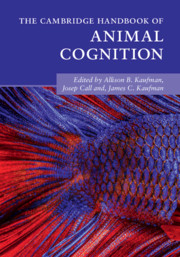Book contents
- The Cambridge Handbook of Animal Cognition
- The Cambridge Handbook of Animal Cognition
- Copyright page
- Dedication
- Contents
- Figures, Tables, and Boxes
- Contributors
- Acknowledgments
- Introduction
- Part I Communication and Language
- Part II Memory and Recall
- Part III Social Cognition
- 11 Social Cognition Overview
- 12 Proximate and Ultimate Mechanisms of Cooperation in Fishes
- 13 Evolutionary and Neural Bases of the Sense of Animacy
- 14 Raven Social Cognition and Behavior
- 15 Reciprocal cooperation – Norway rats (Rattus norvegicus) as an example
- 16 Exploring the Social Minds of Elephants
- 17 Dolphin Social Cognition
- 18 Mirror Self-Recognition
- Part IV Social Learning and Teaching
- Part V Numerical and Quantitative Abilities
- Part VI Innovation and Problem-Solving
- Index
- References
11 - Social Cognition Overview
from Part III - Social Cognition
Published online by Cambridge University Press: 01 July 2021
- The Cambridge Handbook of Animal Cognition
- The Cambridge Handbook of Animal Cognition
- Copyright page
- Dedication
- Contents
- Figures, Tables, and Boxes
- Contributors
- Acknowledgments
- Introduction
- Part I Communication and Language
- Part II Memory and Recall
- Part III Social Cognition
- 11 Social Cognition Overview
- 12 Proximate and Ultimate Mechanisms of Cooperation in Fishes
- 13 Evolutionary and Neural Bases of the Sense of Animacy
- 14 Raven Social Cognition and Behavior
- 15 Reciprocal cooperation – Norway rats (Rattus norvegicus) as an example
- 16 Exploring the Social Minds of Elephants
- 17 Dolphin Social Cognition
- 18 Mirror Self-Recognition
- Part IV Social Learning and Teaching
- Part V Numerical and Quantitative Abilities
- Part VI Innovation and Problem-Solving
- Index
- References
Summary
The social life of animals poses specific adaptive challenges that may be cognitively different to challenges from ecological adaptations to their physical environment.Social cognitive adaptations for dealing with other agents are evolutionarily remarkable in that they automatically become an adaptive challenge that may trigger counter- or co-adaptations. This chapter discusses three main problems in social cognition: first, the issue of mentalism or theory of mind, or whether social cognitive adaptations in animals are based on mentalistic attribution skills that may involve representing the intentions and knowledge of others; second, the cognitive underpinnings of animal communication, with a focus on referential and intentional communication; and third, the problem of how animals know and represent the social relations structuring their groups. There is widespread debate about how the social knowledge and reasoning demonstrated in animal social behavior are exactly implemented. The traditional debate in comparative psychology between reductionist behavioristic explanations and complex cognitive explanations has become especially pronounced in social cognition. A widespread proposal is that the type of knowledge demonstrated by animals is ‘implicit,’ distinct both from the verbally expressible knowledge evolved by humans, and from low-level, reflex-like associative behaviours and habits. However, the key notion of implicit knowledge remains elusive and ill-defined.
Keywords
- Type
- Chapter
- Information
- The Cambridge Handbook of Animal Cognition , pp. 225 - 271Publisher: Cambridge University PressPrint publication year: 2021



